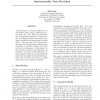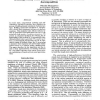352 search results - page 51 / 71 » The Structure of First-Order Causality |
ICRA
1995
IEEE
13 years 11 months ago
1995
IEEE
A generic architecture for evolutive supervision of robotized assembly tasks is presented. This architecture , at different levels of abstraction, functions for dispatching action...
EDM
2008
13 years 9 months ago
2008
This paper discusses our approach to building models and analyzing student behaviors in different versions of our learning by teaching environment where students learn by teaching ...
UAI
2001
13 years 9 months ago
2001
An instrument is a random variable that is uncorrelated with certain (unobserved) error terms and, thus, allows the identification of structural parameters in linear models. In no...
AIPS
2000
13 years 9 months ago
2000
This paper develops Probabilistic Hybrid Action Models (PHAMs), a realistic causal model for predicting the behavior generated by modern concurrent percept-driven robot plans. PHA...
AAAI
1996
13 years 9 months ago
1996
In recent years, compositional modeling and selfexplanatory simulation techniques have simplified the process of building dynamic simulators of physical systems. Building steady-s...


